
Fast, affordable Internet access for all.

We finally see television news outlets asking the tough questions of bill pushed by powerful cable and telephone companies to prevent giving residents a real choice in cable and Internet service providers. We been covering this Georgia bill closely, and were glad to see this segment:
This video is no longer available. The segment makes an error in suggesting that tax dollars are commonly used by local governments in building networks. They are not. Most municipal networks are built using revenue bonds, where the community does not pledge its full faith and credit. Instead, they sell bonds to private investors who are then repaid by the revenues generated by the network. But this mistake is more than outweighed with the reveal at end of the video, that the municipal network in Thomasville allowed the city to drop its local property entirely. Yet another community benefiting tremendously from owning its own network.Even as the Internet is changing every aspect of our lives and communities, most Americans are intimidated by confusing jargon and misconceptions about Internet policy. We are developing a series of fact sheets that make these issues understandable to everyone.
We presently have fact sheets from the Institute for Local Self-Reliance and other organizations that cover broadband, financing networks, wireless Internet, economic development benefits from community owned networks, and the public savings from community owned networks.
Stay up to date with these fact sheets and other developments in community owned networks, subscribe to our one-email-per-week list. Once a week, we send out an update with new stories and resources.
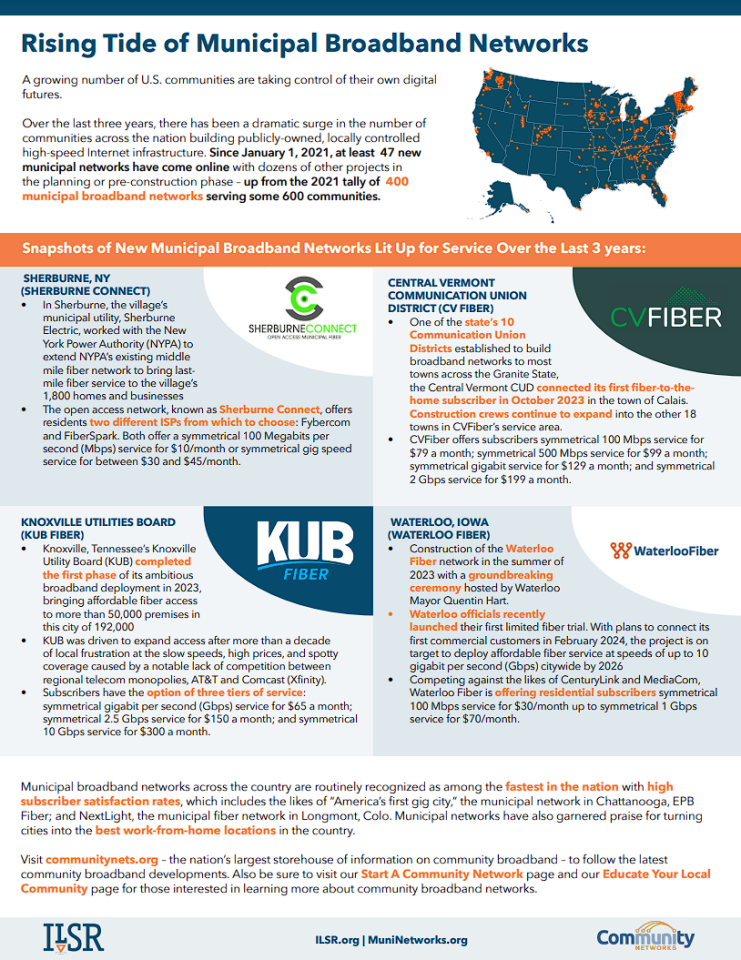
The municipal broadband movement continues to gain momentum. Since January 1, 2021, at least 47 new municipal networks have come online with dozens of other projects still in the planning or pre-construction phase, which includes the possibility of building 40 new municipal networks in California alone. To help encapsulate this dramatic surge in the number of communities building publicly-owned, locally controlled high-speed Internet infrastructure, we created this fact sheet to provide pertinent numbers and highlight four recently launched networks now providing service to communities hungry for high-quality Internet connectivity, choice, competition.
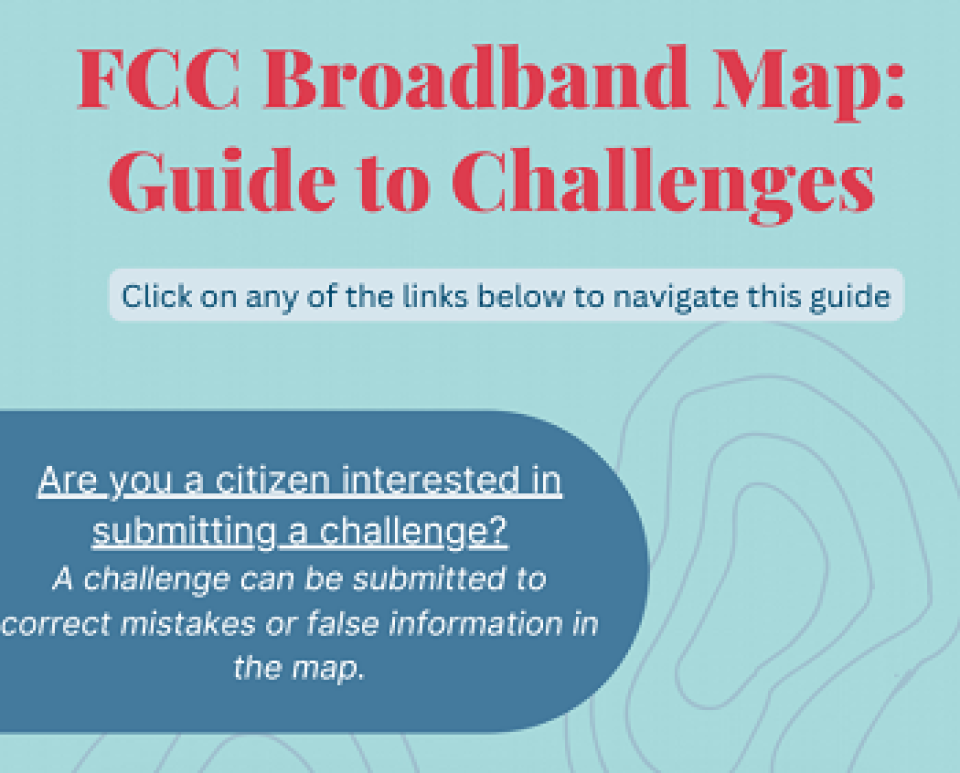
With good reason, many are confused about the information shown in the FCC's new Broadband Availability map, the challenge process, and why we should care about helping the FCC make corrections. We believe it is important to contribute to improving this map to enable an equitable allocation of Broadband Equity, Access, and Deployment (BEAD) Program funds to states next year. In an effort to provide a better understanding of the map itself and the challenge process we created a short series of instructional videos and a click-through guide. FCC Broadband Map Challenge Guide [pdf]
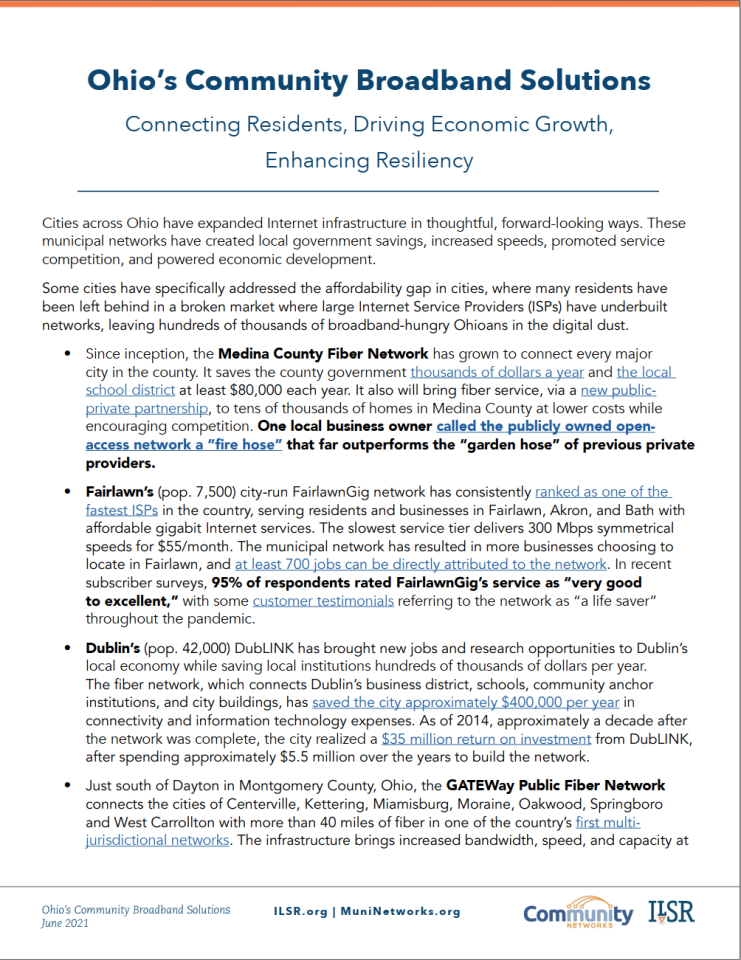
Cities across Ohio have expanded Internet infrastructure in thoughtful, forward-looking ways. These municipal networks have created local government savings, increased speeds, promoted service competition, and powered economic development. Some cities have specifically addressed the affordability gap in cities, where many residents have been left behind in a broken market where large Internet Service Providers (ISPs) have underbuilt networks, leaving hundreds of thousands of broadband-hungry Ohioans in the digital dust. This fact sheet outlines the many long-term benefits that municipal broadband projects have brought to the state.
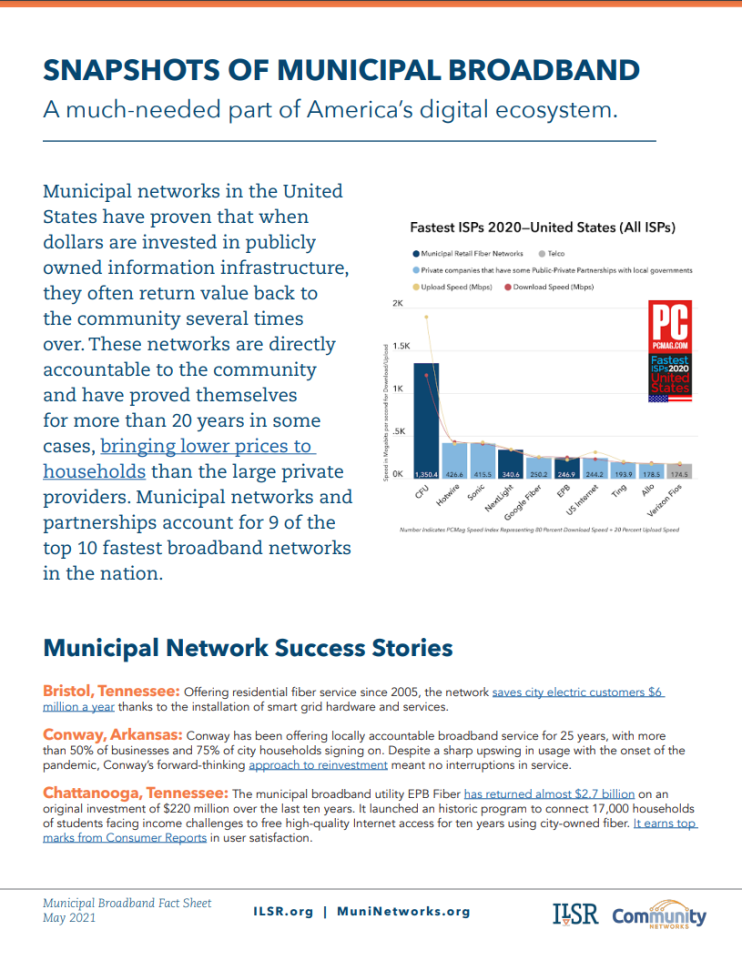
Municipal networks in the United States have proven that when dollars are invested in publicly owned information infrastructure, they often return value back to the community several times over. These networks are directly accountable to the community and have proved themselves for more than 20 years in some cases, bringing lower prices to households than the large private providers. Municipal networks and partnerships account for 9 of the top 10 fastest broadband networks in the nation. This new fact sheet highlights municipal broadband success stories from across the country and some of the many benefits the networks have brought to the communities they serve.
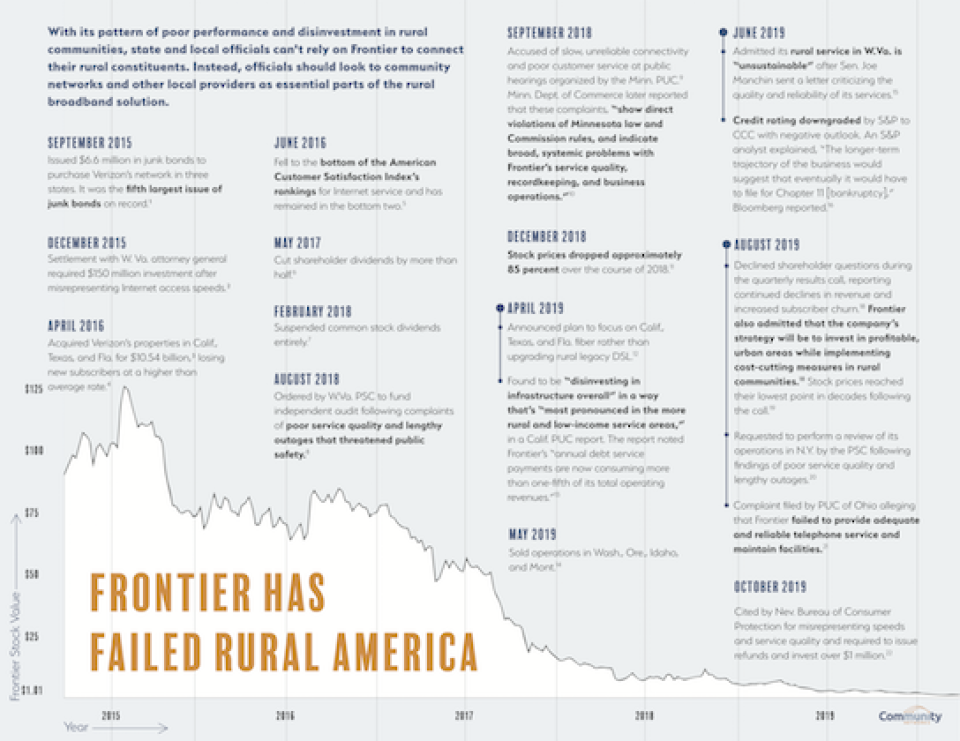
Despite raking in hundreds of millions in government broadband subsidies, Frontier Communications has failed time and time again to bring reliable, high-speed connectivity to the rural communities it serves. Instead of investing in network upgrades, Frontier has neglected its rural infrastructure to the detriment of its subscribers and the company’s own financials, with its worsening service quality paralleling its plummeting stock value. This fact sheet presents evidence of Frontier’s negligence and suggests that rather than continuing to trust Frontier, government officials should look to publicly owned and community-minded providers to connect rural residents, businesses, and institutions.
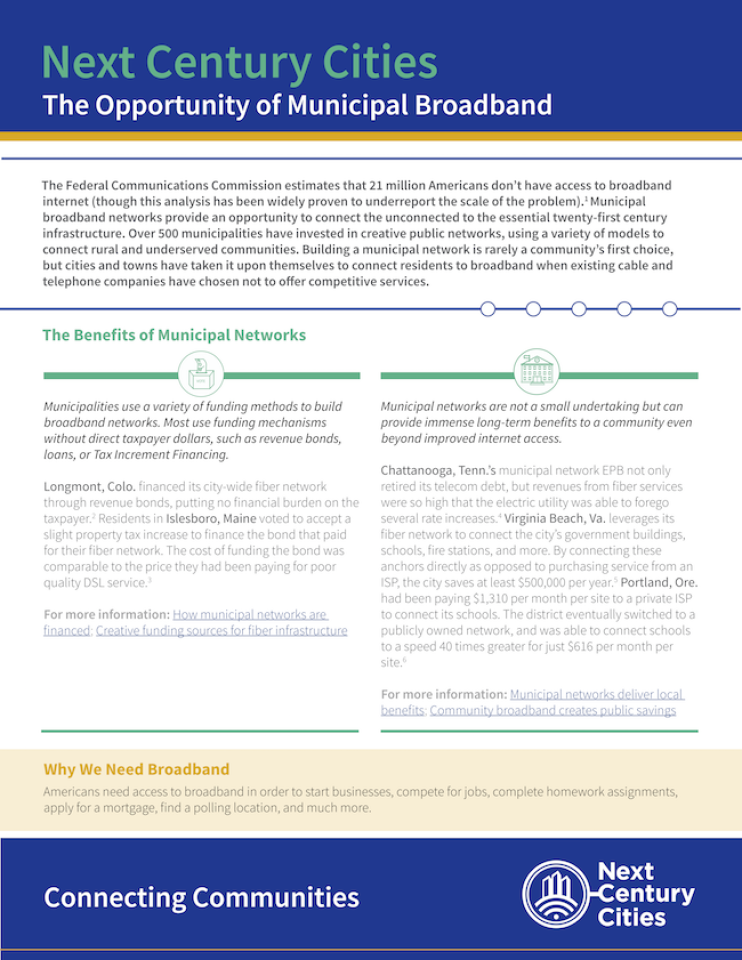
Next Century Cities (NCC) helps communities across the U.S. connect to each other, find resources, and discover ways to improve local Internet access options. NCC’s fact sheet uses examples from municipal network history. Communities have invested in publicly owned fiber optic infrastructure to obtain better connectivity and to reduce telecommunications costs for municipal facilities. In more than a few places, those investments became the foundation for what later became networks to serve local businesses and residences. The fact sheet also delves into other benefits, such as economic development, improved efficiency of other utilities, and accountability.
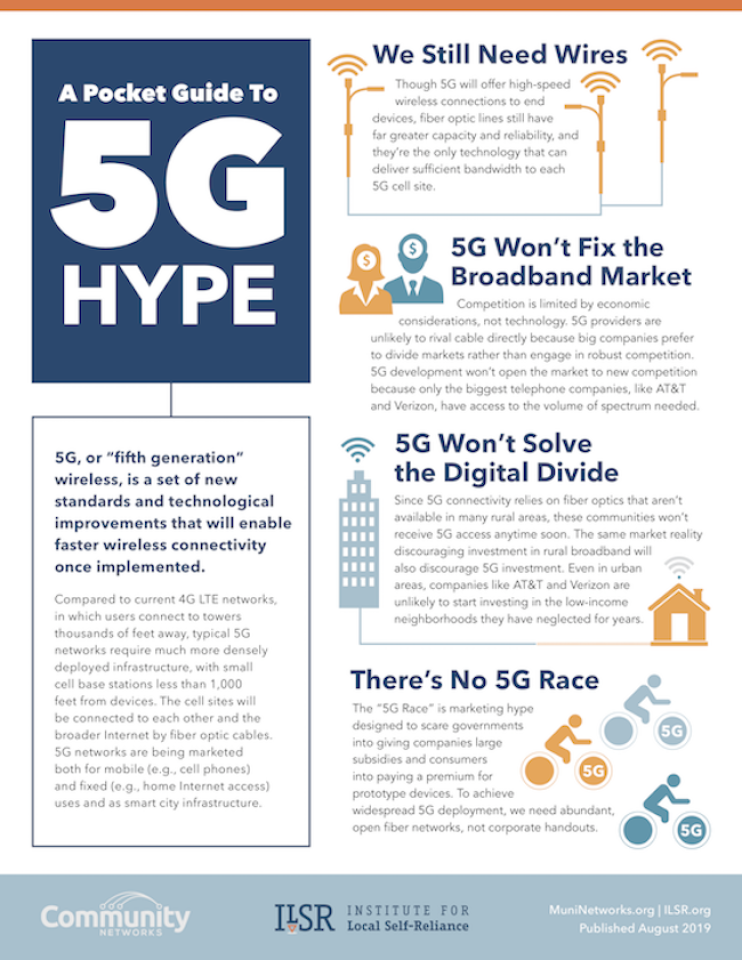
It’s difficult to separate 5G fantasy from reality as reported in traditional news sources. Misunderstandings surrounding the demands and capabilities of 5G has snowballed, creating an incorrect assumption that the technology will solve America’s many connectivity problems. It’s true that 5G is an improvement, but it has limitations. This fact sheet addresses the most repeated errors surrounding 5G and explains why the technology should be considered another tool, not an exclusive remedy.
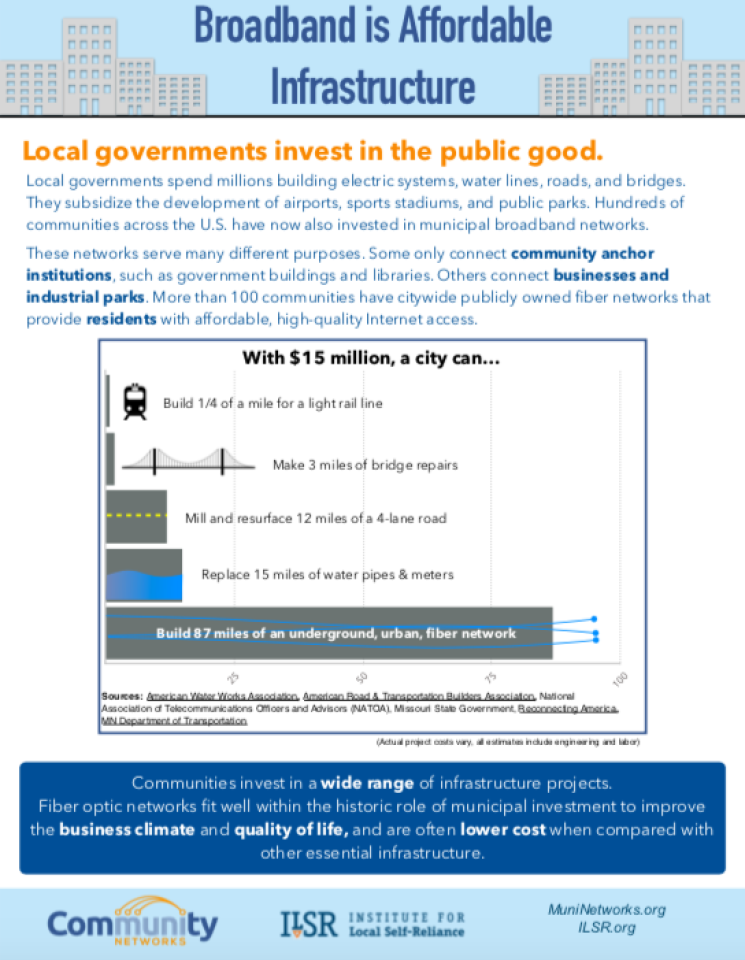
Local governments spend billions on all sorts of infrastructure every year to advance the public good for their communities. Roads and bridges keep day-to-day activity moving. Investments such as water and sewer infrastructure keep cities clean and livable. Fiber infrastructure is used for a wide range of purposes, including economic development, education, and to keep a city’s administration connected. To get a look at how fiber network infrastructure compares to other public investments, we've developed the Broadband is Affordable Infrastructure fact sheet.
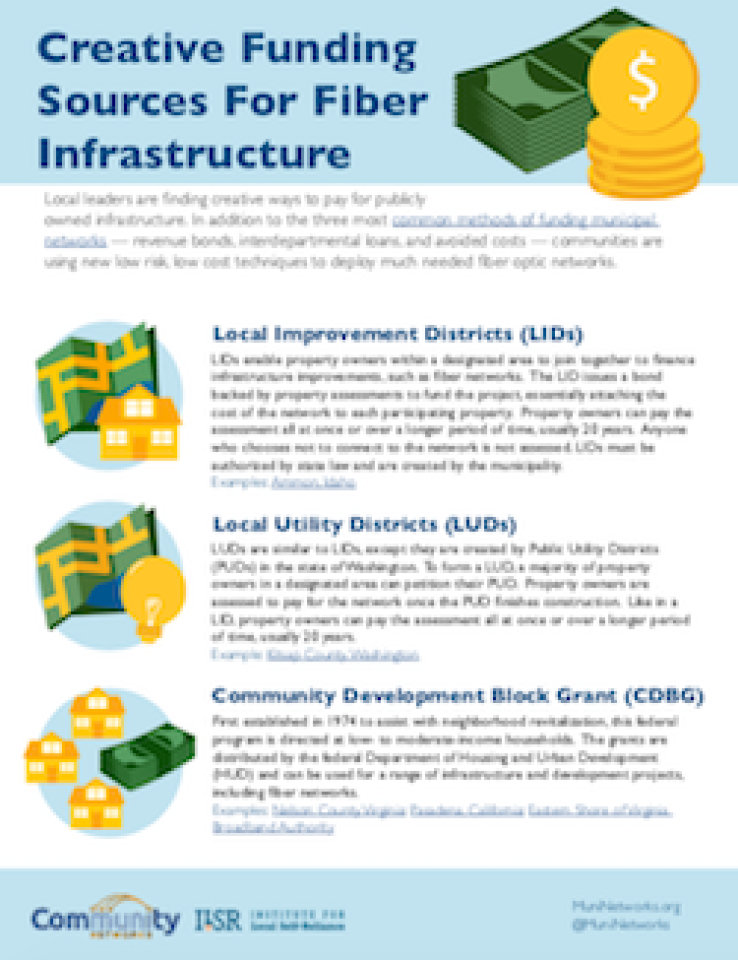
As interest in publicly owned broadband network infrastructure increases, local communities seek new ways to fund municipal networks. Revenue bonds, interdepartmental loans, and avoided costs have been the three most common methods for funding Internet network infrastructure, but local leaders are finding creative approaches to get the job done. In this fact sheet we analyze some new approaches to funding fiber optic infrastructure, pros and cons, and offer some examples.
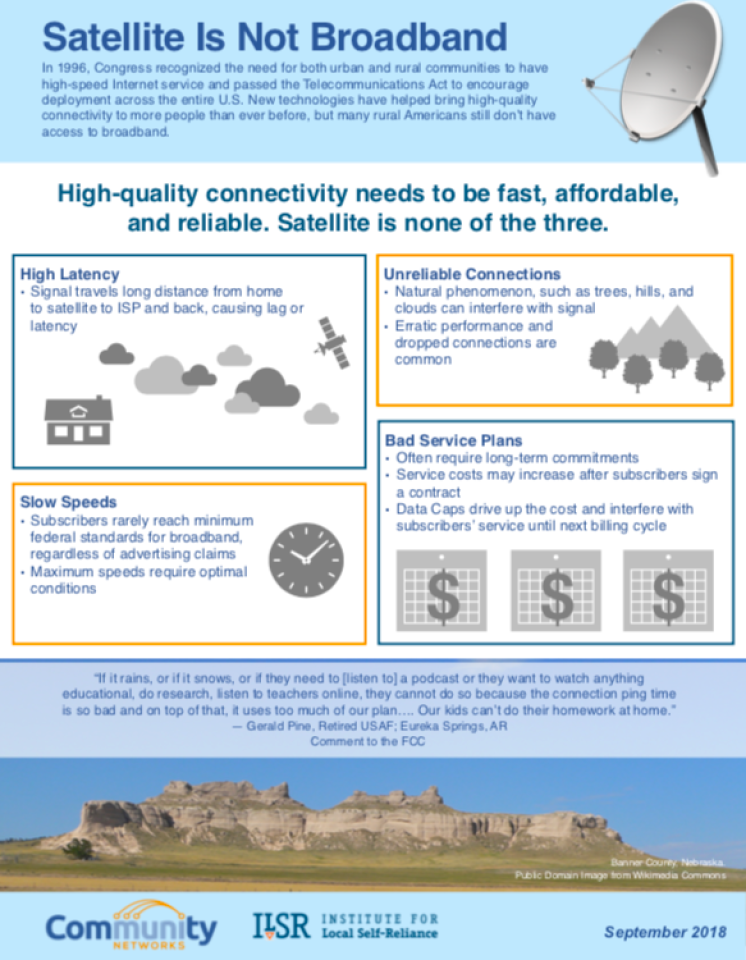
As a nation our goal is ubiquitous broadband coverage so every person, regardless of where they live, can obtain the fast, affordable, reliable Internet access necessary for modern times. For people in rural areas, where large national wireline providers don’t typically invest in the infrastructure for high-quality connectivity, satellite Internet access is often their only choice. In this fact sheet we address some of the reasons why depending on satellite Internet access to serve rural America is a mistake.
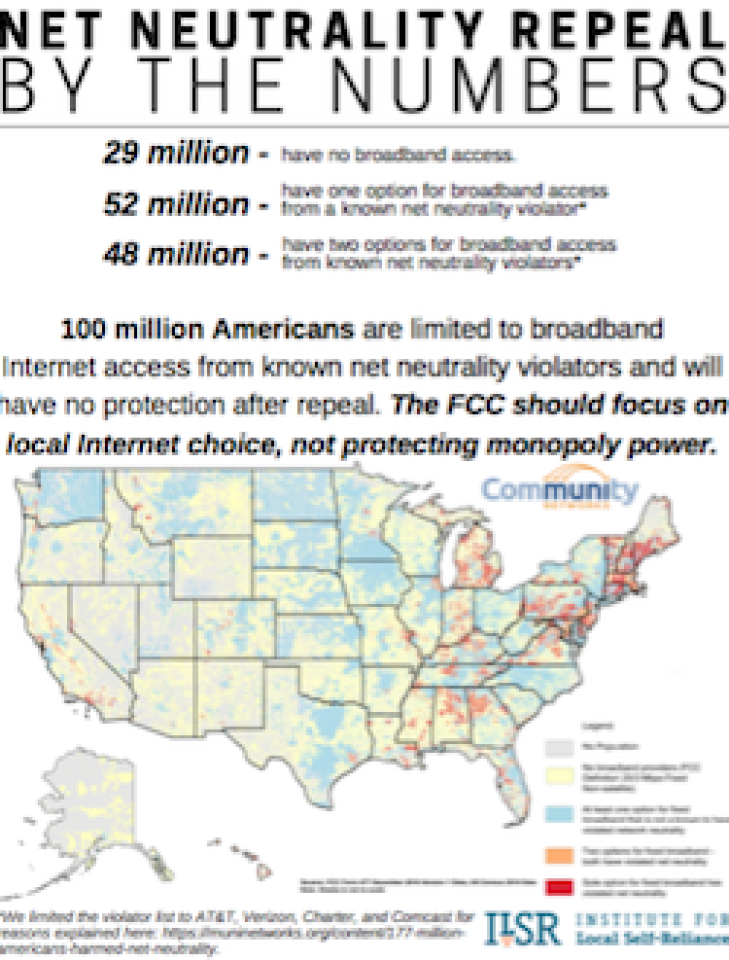
As the vote to repeal network neutrality protections approached in 2017, we started digging into the FCC’s data to determine how eliminating the policy would affect subscribers whose ISPs might take advantage of future changes. We learned that, due to existing monopoly and duopoly conditions, many millions of people would have no recourse but to pay known network neutrality violators for Internet access. We developed visuals and facts sheets with frank data that describes the problem in the U.S., California specifically, and on the East Coast from Maine to Virginia.
Net Neutrality Repeal By The Numbers, U.S.A. Edition fact sheet [pdf].
Net Neutrality Repeal By The Numbers, California Edition fact sheet [pdf].
Net Neutrality Repeal By The Numbers, East Coast Edition fact sheet [pdf].
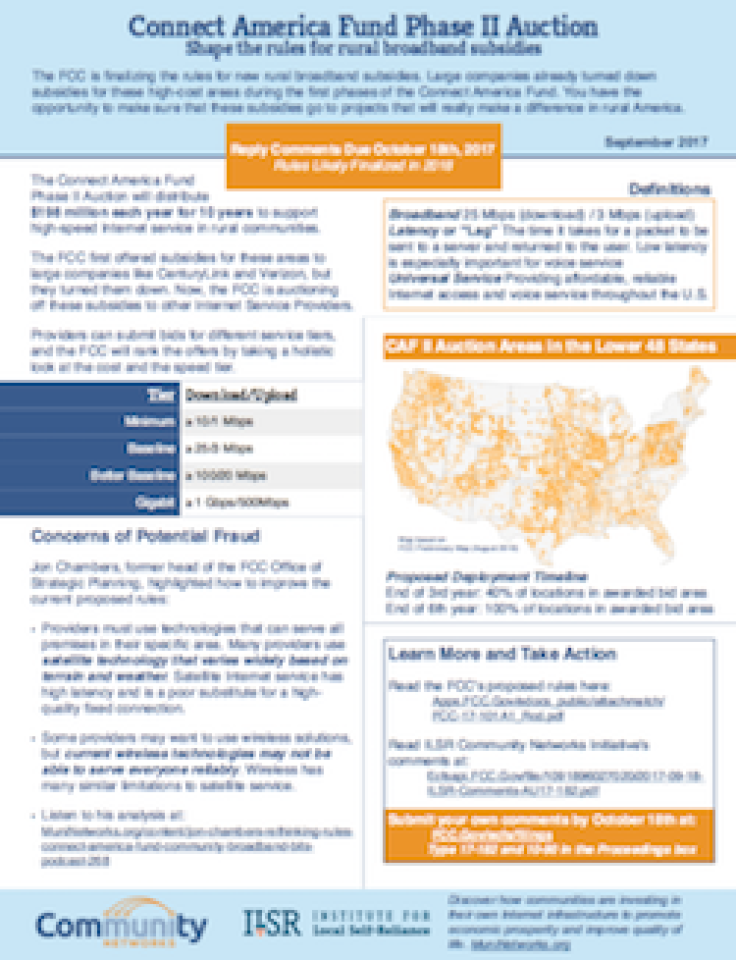
The Federal Communications Commission (FCC) manages the CAF program, which provides billions of dollars in subsidies to Internet service providers for areas where the cost of building networks is prohibitive. Some large providers decided not to accept some of the subsidies during Phase I - about $198 million annually for 10 years. This fact sheet details the most important aspects of the Connect America Fund (CAF) Auction. What is it? What should it do? Who does it affect?
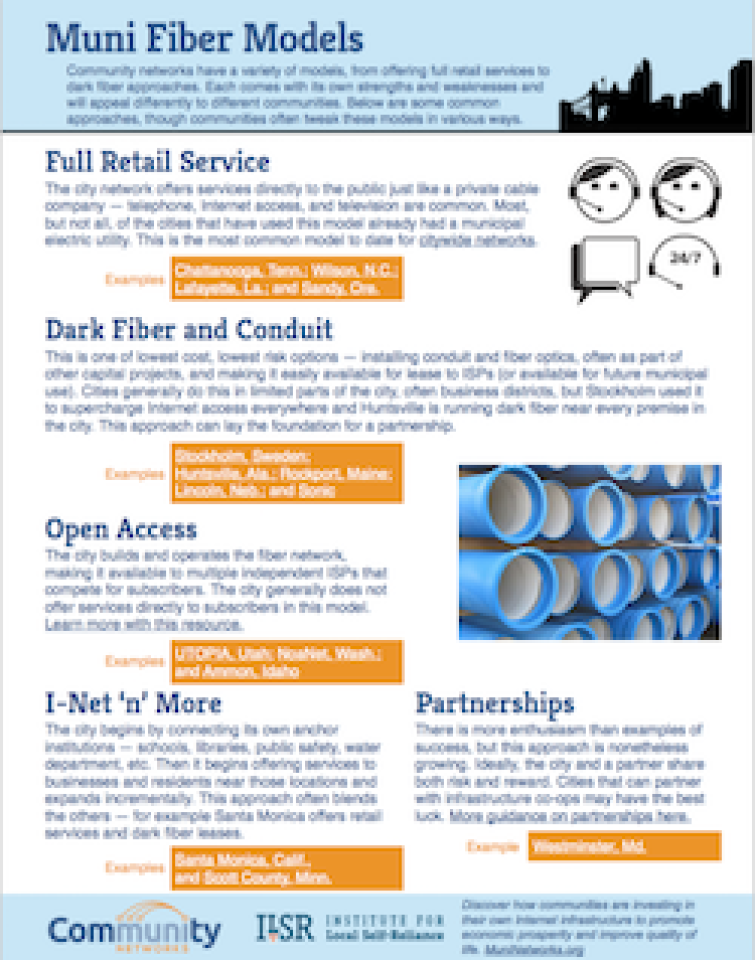
When you think “municipal fiber network,” you may think Chattanooga or Wilson, North Carolina - places where the city utility offers retail services directly to subscribers. That’s only one of several possible models that are emerging as an increasing number of communities use publicly owned assets to improve local connectivity. This fact sheet offers five of the most well known models that local governments are investigating and implementing as they become more self-reliant. Examples and characteristics of each model help illustrate.
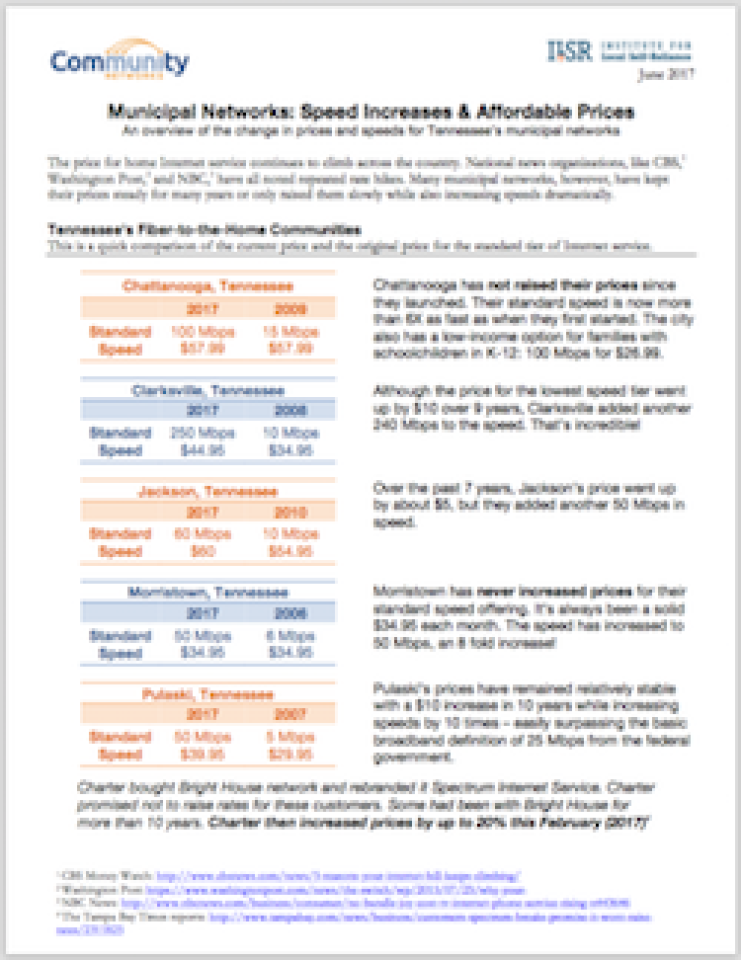
The large corporate national Internet Service Providers seem to raise their monthly rates every year but don’t give subscribers anything more for their money. On the flip side, we noticed that municipal networks tend to increase speeds for subscribers with very modest or no price increases over long periods of time. In order to illustrate this phenomenon, we looked back in time at rates and speeds in eight Tennessee communities that have invested in publicly owned Internet network infrastructure. You will see how speeds have increased significantly, but rates have only inched up.
Municipal Networks: Speed Increases & Affordable Prices [pdf]
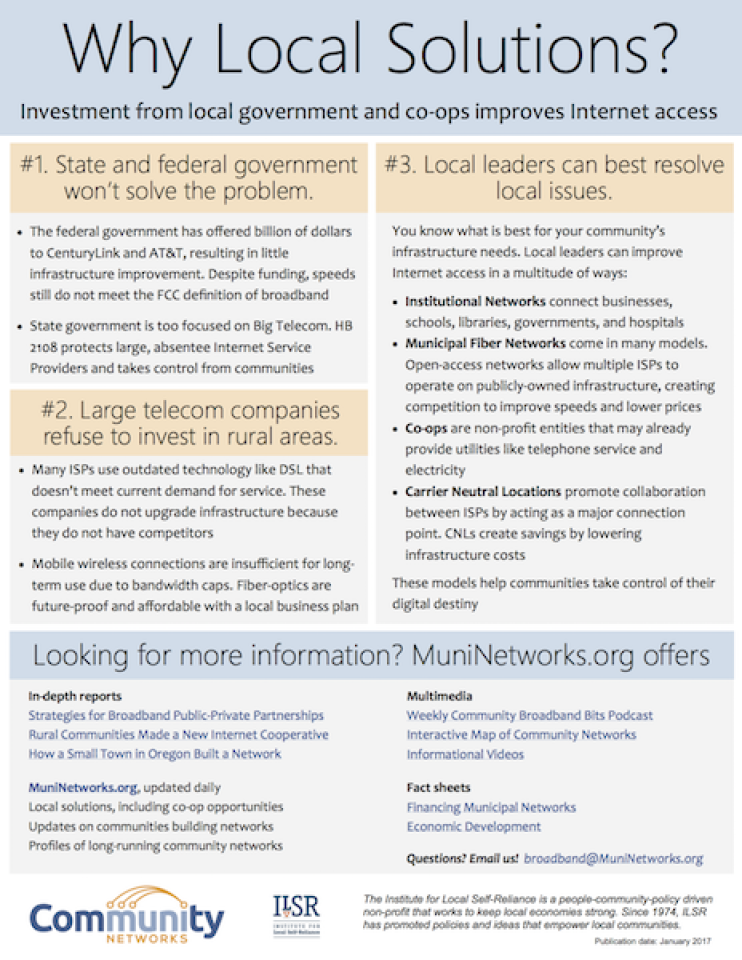
The next time you’re attending a city council meeting, a local broadband initiative, or just chatting with neighbors about better local connectivity, take a few copies of our fact sheet. In addition to providing some basic talking points to get the conversation moving, the fact sheet offers resources to guide you to more detailed information on publicly owned Internet networks. You've already started to get people interested in all the advantages of high-quality connectivity, now show them how local self-reliance it the most direct route to better access.
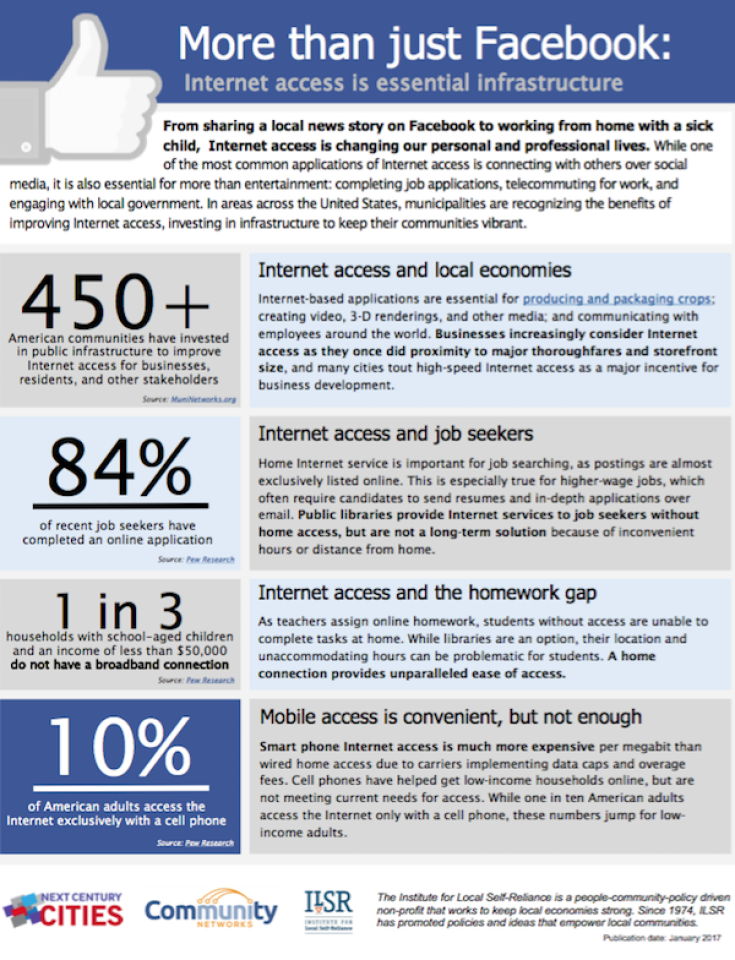
This fact sheet provides an overview on how Internet access and fast, affordable, reliable connectivity reaches most aspects of our lives. It provides statistics on economic development, education, and methods of delivering Internet access and is a good introductory tool that points out how Internet access is much more than just social media.
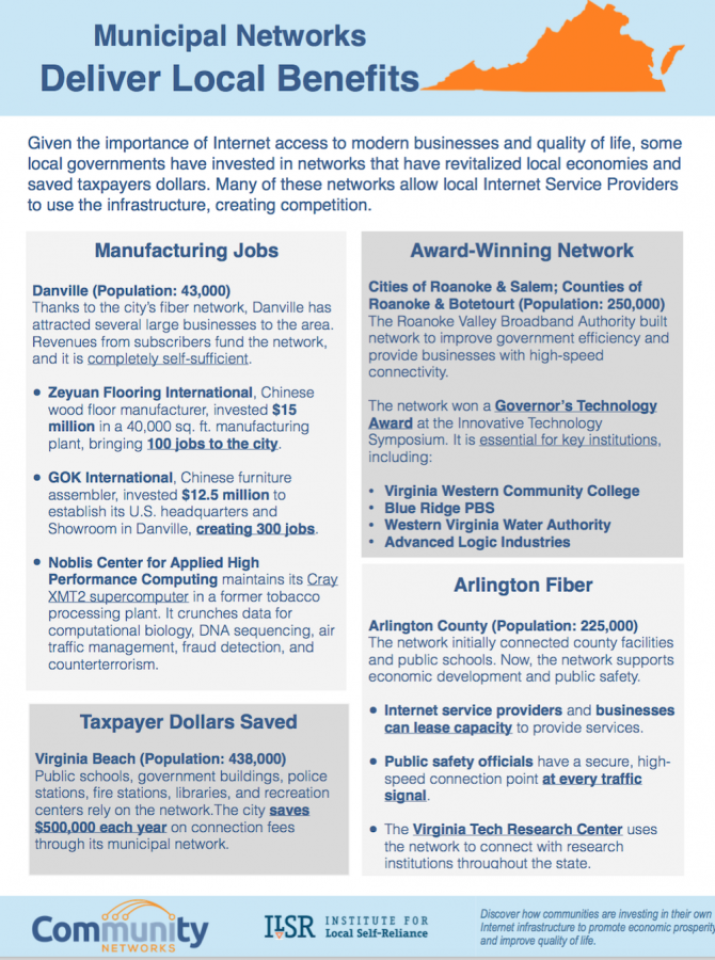
This fact sheet on municipal networks in Virginia describes how economic development, public savings, and better connectivity have contributed to the health of local communities with publicly owned networks. Virginia local governments have improved public safety, healthcare, and connectivity in local schools. Rural areas are better able to compete for high-tech and manufacturing jobs because high-speed connectivity is now an essential service for day-to-day business.
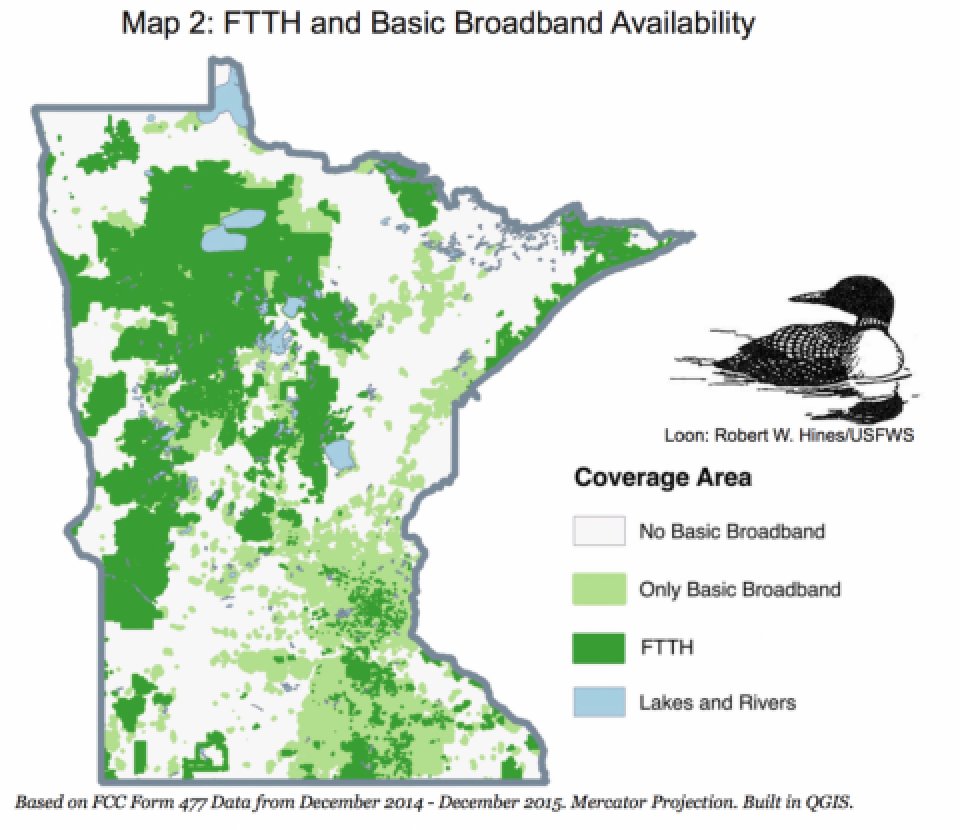
This fact sheet highlights the great work that Minnesota cooperatives and municipalities have done to bring fast, affordable, reliable Internet service to rural areas throughout the state. They've built many Fiber-to-the-Home (FTTH) networks, but there is still much work left to do. One in 4 Minnesotans lives in a rural area, and of those rural households, 43 percent lack access to broadband, defined by the FCC as 25 Megabits per second (Mbps) download and 3 Mbps upload. Resilient, robust, fiber is the long-term goal, but fixed wireless can help extend coverage in hard-to-reach rural areas.
Minnesota Cooperatives and Local Governments Can Solve Rural Digital Divide[pdf]
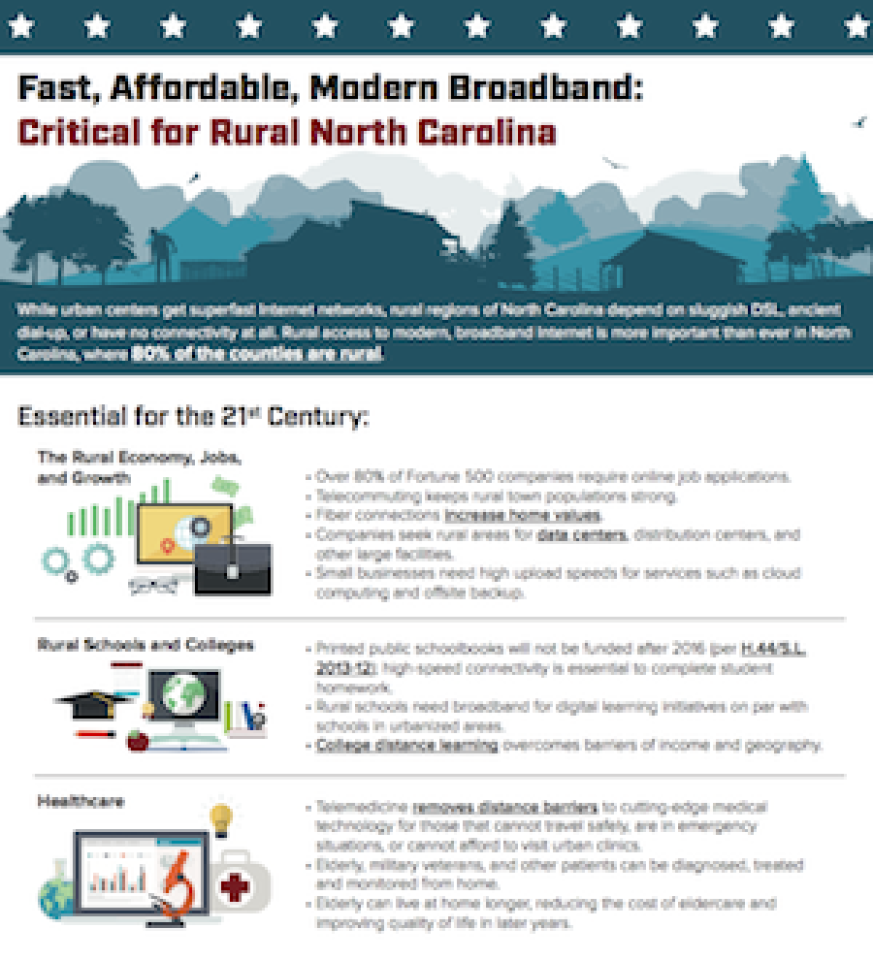
This fact sheet emphasizes the deepening divide between urban and rural connectivity. The fact sheet can help describe why people who live in the country need services better than DSL or dial-up. This tool helps to visualize the bleak situation in rural North Carolina, how it can be improved, and offers links to resources.
Fast, Affordable, Modern Broadband: Critical for Rural North Carolina [pdf]
Communities across the nation have invested in publicly owned cable and fiber infrastructure. ILSR's Community Networks Map documents over 500 communities where municipal networks serve residents and businesses. This fact sheet provides a quick introduction to the interactive online map.
When a community decides it needs to establish its own publicly owned network infrastructure, one of the biggest challenges is financing the investment. Each community is unique but three main methods of financing are most popular. This fact sheet offers a quick look at these common approaches and provides real-world examples.
This is a handy resource for elected officials and activists that are confused by some of the jargon or just want to make sure they understand some key ideas around broadband and telecommunications.
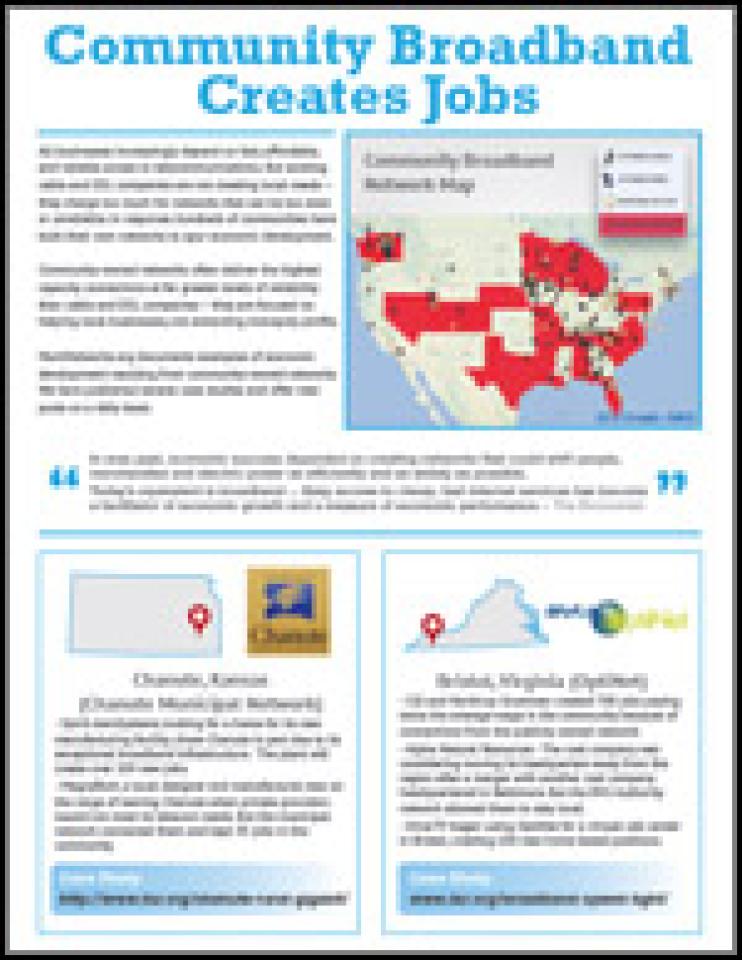
Community Broadband Networks have a very good track record in creating jobs. This fact sheet details where publicly owned network attracted new businesses or helped existing businesses to thrive.
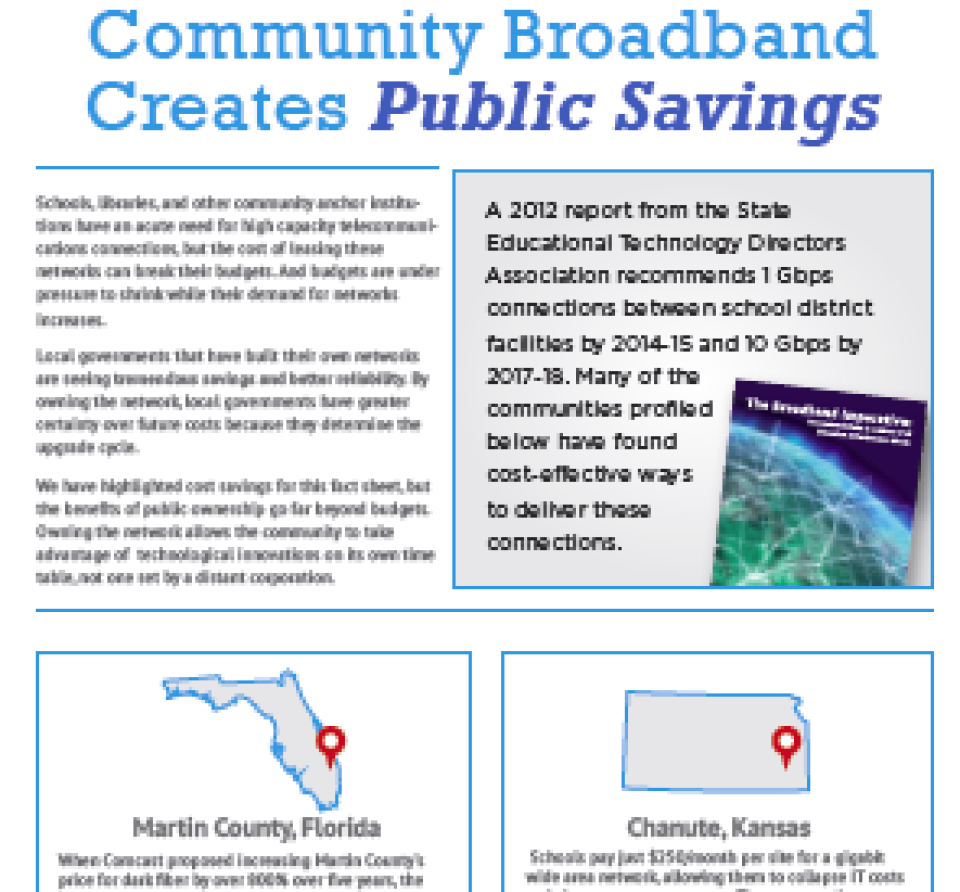
Though schools, libraries, and other community anchors need access to faster, more reliable networks, the big cable and telephone companies have priced those services so high that they are breaking the budget. But when communities create their own connections, affordable high capacity connections aren't the only benefits.
Wireless networks may appear to be magical, but are actually driving investment in fiber optic wires. This resource defines many terms, key points, common speeds, and offers insight into wireless technology and policy.
This 2 page fact sheet explores the issue of preemption - how at least 19 states have made it impossible or more difficult for communities to build their own networks. It includes some history, legal issues, and quotes from FCC Commissioners.
This past spring, we introduced you to the small town of Leverett, in rural western Massachusetts. Having been largely ignored by the cable companies and left behind by Verizon's DSL service, the community overwhelmingly approved a town-owned network initiative in a May vote. They decided to finance the FTTH network with a 20-year bond measure.
The debt will be serviced by both the revenues from selling services on the network and a modest increase in property taxes estimated at 6%. Local leaders calculate the increase in property taxes will amount to less than the savings created by lowering existing DSL and telephone services.
Peter d'Errico, of the Leverett Broadband Committee gave us an update via email:
We issued a Request for Information (RFI) in September. Thirteen respondents gave us a wealth of information about the state of the industry and their readiness to engage with our project. Based on this information, together with our already-completed network design, we are now crafting an Invitation for Bids (IFB) for the network build and one year's maintenance. We expect to issue the IFB early January, with a return date in February, which will allow us to select a contractor shortly thereafter.
As soon as we issue the IFB, we will draft a Request for Proposals (RFP) for network operator / service provider. This will also be based on the information gathered from the RFI and our design.
We have initiated the 'make-ready' process with the local utility and phone company.
A November Gazette.Net article [requires login] on the project described some temporary setbacks due to Hurricane Sandy and an October storm that came through the area. In order to keep the project momentum going, the committee is gathering the pieces needed now and in the future. Early prep work will make launching the network that much easier. From the article:
In August, we reported on the results of a report on UTOPIA by the Office of the State Auditor General of Utah. As you will recall, the results were less than favorable and presented more fodder for those opposed to municipal telecommunications infrastructure investment.
The same old arguments often rest on the financial investment in municipal networks - they are considered failures if they don't break even or make money. Pete Ashdown, founder of ISP XMission in Utah, addressed those arguments in the Salt Lake Tribune:
UTOPIA provides broadband service in 11 Utah cities. Today, communication infrastructure is no less critical than transportation, sanitation and clean water. Government is not a business, but the infrastructure it provides contributes to a robust business environment.
Consider how private businesses rely on government funded infrastructure. Why don’t entrepreneurs clamor to build the next generation of roads? Why don’t airline companies get off the public dole and build their own facilities? Why are sewer facilities so rarely handled by anyone else but the state?
Does effective infrastructure cost? Considerably. Does it make a profit? No.
For decades now, public service entities have contended with the argument that if they are "run it like a business" they will be more efficient, productive and even profitable. While lessons from the private sector may contribute to increased efficiency at times, government is NOT a business. Applying business tenets should be done sparingly and not in the case of critical infrastructure like electricity, roads, and yes, access to the Internet.
Gary D. Brown, who lives in Orem, shared a guest opinion through the Daily Herald and drew a similar parallel between UTOPIA's status and the business world:
A recent book by David Cay Johnston, The Fine Print, examines specifically how big companies have found ways to take advantage of the tax and regulatory systems to their benefit and to the detriment of consumers. The sad part - we don't even realize it.
Johnston discusses how big companies and their leaders exploit tax rules to re-distribute wealth upwards. Johnston also examines how this exploitation is almost never covered in the media, encouraging big companies to stoop to new lows in ripping off consumers. Telecommunications is one of the industries he covers in the new book.
In the first chapter (read the first chapter via Democracy Now!), Johnston describes how friend and journalist, Bruce Kushnick, came across twenty years' worth of telephone bills in his elderly aunt's possessions. Kushnick tracked the changes in her bills, systematically reviewing and comparing every charge. Kushnick found an array of confusing and cryptic "fees," "charges," and "taxes." The end result:
When he cross-checked his aunt’s telephone bills over the years, he could hardly believe the numbers. His aunt paid $9.51 for her local phone service in 1984. By 2003 her bill had swollen fourfold to $38.90. In the two decades since the breakup of the AT&T monopoly, even after adjusting for inflation, his aunt’s telephone cost $2.30 for each dollar paid in 1984. And that was without any charges for long-distance calls.
Johnston notes the method used by telecoms to increase prices over time:
We brought you news of Leverett, Massachusetts and their decision this spring to pursue a municipal fiber optic network. In April, voters approved a measure to develop the initiative, and this past weekend took the last step toward building the network. The town of 1,851, voted to raise their taxes to pay for a fiber-to-the-home network. The result was a resounding 462 for and 90 against.
The GazetteNET.com covered the story:
"We're expecting everyone in Leverett to have access to this network by 2014," said Peter d'Errico, a member of the town's Select Board and a leading supporter of the municipal fiber-optic system."
"This was clearly a mandate to proceed," said d'Errico. "There was vigorous discussion at every stage of the process and it's a sign that community is ready to take charge of its own services."
The Proposition 2 1/2 debt exclusion override ended in an 83.5% vote to support the project. The result satisfies the 2/3 majority requirement for a planned tax increase, as required by state law.
A little more than 39% of the town's eligible voters cast ballots. According to the assistant town clerk, D'Ann Kelty who monitors voter activity, the turn out was large for a single issue election.
The funding strategy is a 20-year bond measure and is expected to increase property taxes by 6%. Supporters note that a 6% hike in property taxes is less than what households will save in telephone and internet bills. They will be paying less for something far better than they now receive. According to residents, telephone service has been spotty for years, due to old copper wires that have not been replaced by providers. In a recent GazetteNET article before the vote:
A lot of cities have been talking property tax hikes lately, and the most certain thing about all of the proposals is that elected officials are going to look for someone or something to blame. In UTOPIA member cities, blaming the fiber network has become the easy go-to solution, especially since so many mayors and city council members weren’t involved in the original decision. The problem, however, is that this blame is completely paving over a deeper problem of city tax structure that’s boring, doesn’t fit the anti-UTOPIA narrative, and is a much larger problem for city budgets. Let’s take the examples of West Valley City, Orem, and Taylorsville, the latter of which is not a UTOPIA member city. In all three cases, they’ve called for large (as a percentage) property tax increases to make up for lagging sales tax revenues. So if UTOPIA is the cause of property tax increases, why would a non-member city need to more-or-less do the same thing?The discussion in the comments offer some additional news about UTOPIA's efforts to expand its subscriber-base by giving residents the option of "leasing" a last mile connection if they cannot afford to pay for it outright in areas where UTOPIA is presently not able to extend its network all the way to the home. Communities seeking alternative ways of financing networks that simply issuing lots of debt upfront should examine the different approaches UTOPIA has pioneered.
Recently, we let you know about the situation in Siloam Springs, Arkansas, population 15,039. The town is now investigating the possibility of building their own fiber network. They have had several community meetings and a "vote of the people" is set for May 22, 2012.
Pamela Hill is investigating the twists and turrns in a series of articles about the vote. In one of her articles, Hill looked into another Arkansas community, Paragould, home of the annual "Loose Caboose" Festival. This community, located in the northeast corner of the state, has successfully operated their own cable network since 1991. Unlike Siloam Springs, the people of Paragould weren't focused first on generating new revenue for the local government, they just wanted to be able to watch tv for a reasonable price.
Back in 1986, Cablevision was the only provider in Paragould. Hill spoke with Rhonda Davis, CFO of Paragould Light, Water & Cable:
"The public wasn’t happy with Cablevision’s service or rates,” Davis said. “We took it to a public vote and did it.”
Prior to Paragould's decision to build their own network, the City had a nonexclusive franchise agreement with Cablevision. The town was dissatisfied by the service they received and, in 1986, Paragould voters approved an ordinance authorizing the Paragould Light and Water to construct and operate a municipal cable system. Three years later, there was a referendum that authorized the city to issue a little over $3 million in municipal bonds to finance the system.
That same month, Cablevision filed suit alleging antitrust violations, breach of contract, and infringement of first and fourteenth amendment rights. The district court dismissed the antitrust and constitutional claims and Cablevision appealed unsuccessfully. The case attracted attention from lawyers and business scholars across the country.
Not long ago, we told you about Leverett, Massachusetts, the small town of 1,851, that has been discussing the possibility of building a community network. Residents and businesses currently use a combination of satellite, dial-up, DSL, and wireless, and about 6% of the population has no Internet access at all. People are tired of lost opportunities in a town strategically situated near several colleges. The town just approved the proposal to invest in a municipal network.
Last Saturday, April 28th, the measure to build the network was approved at Leverett's Annual Town Meeting. The needed two-thirds vote came easily, with 306-33 in favor, at the packed meeting at the Leverett Elementary School auditorium. Enthusiasm and expectations are high. From a Fran Ryan article in the Gazettenet.com:
For many, the lack of adequate Internet access has created problems with work, school and even the ability to sell their homes.
"Right now we have hopeless telephone service, useless cellphone service, and no internet service," said resident Raymond Bradley. "This will completely change our lives,"
The current plan is to borrow $3.6 million to create a fiber-optic network that will connect every home and provide triple play services across town. As you may recall from our earlier article, Internet access is only part of the problem - Leverett has had longstanding difficulties with telephone service due to decaying infrastructure. The situation is so bad, the State Department of Communications ordered Verizon to make repairs in over 100 towns in western Massachusetts. With this vote, however, Leverett has decided to take control of its own fate.
Leverett received a $40,000.00 planning grant from the Massachussetts Broadband Institute and benefited from the expertise and efforts of the Wired West group. Leverett's last mile project will connect with MBI's middle mile project.
According to the Leverett Broadband Committee, the investment will pay off rather quickly. This from an April 18th Ben Storrow GazetteNet.com article:
The 1 gig network is slated to be an aerial build, except where existing utilities are underground, in which instances, fiber cable will also be placed underground. Leverett plans to use a $40,0000 planning grant, obtained from the Massachusetts Broadband Institute, to hire G4S Technology to design the last mile fiber-optic network to connect to MBI's stimulus-funded middle mile. The middle mile project is scheduled to be completed in June, 2013, and Leverett plans to be ready to connect soon after. The goal is to have every home connected with fiber by 2014.
Whereas most communities explicitly choose not to use tax revenue to pay for a community network, Leverett's present plan is for a slight increase in local taxes to assist in the financing. The town will borrow the amount necessary to build the network and pay it back over 20 years using a combination of tax revenue and revenues from the new broadband service. Peter d'Errico, Chair of the MBI Grant Broadband Committee observes that homeowners' net spending figures will decline once the system is in place. From the article:
A town survey concluded a municipal network could offer better Internet and phone service at far cheaper rates than private providers, he said.
"It will be a little more on their tax bill and a lot less on their Internet bill, so overall they will be pay less," d'Errico said.